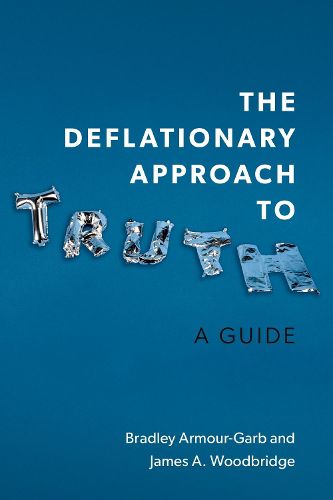Readings Newsletter
Become a Readings Member to make your shopping experience even easier.
Sign in or sign up for free!
You’re not far away from qualifying for FREE standard shipping within Australia
You’ve qualified for FREE standard shipping within Australia
The cart is loading…






"Deflationary" theories are views about truth that are often, but not always, characterized as accounts that accept the utility of the truth predicate without granting the metaphysical or epistemological assumptions that usually go along with it. The Deflationary Approach to Truth: A Guide presents a detailed, up-to-date, and historically informed survey and critical explication of the deflationary approach to the topic of truth, paying special attention to the wide range of various deflationary theories. In Part One, Bradley Armour-Garb and James A. Woodbridge explain what the deflationary approach to truth involves and develop a useful framework that clarifies how it differs from the traditional, "inflationary" approach. The framework illuminates certain general deflationary themes in terms of what Armour-Garb and Woodbridge call broad four-dimensional deflationism. This analysis reveals four different dimensions that any deflationary account must satisfy: Linguistic Deflationism, Metaphysical Deflationism, Conceptual Deflationism, and Paradox Treatment Deflationism. Armour-Garb and Woodbridge examine the degree to which these dimensions are displayed in early, "proto-deflationary" accounts before explaining the different contemporary deflationary views and assessing the degree to which these accounts adhere to the four deflationary dimensions, differ from inflationism, and differ from each other. In Part Two, Armour-Garb and Woodbridge examine various challenges to deflationism, systematizing them by considering each deflationary dimension and grouping the challenges in terms of which dimension they target. For each challenge, they explain its historical development and investigate the extent to which the most prominent contemporary deflationary accounts answer, or fail to answer, that challenge. In Part Three, Armour-Garb and Woodbridge explore fruitful new directions for deflationism and develop a version of the approach that they think best handles the challenges that are examined in Part Two. The result is an accessible yet comprehensive overview of the challenges to and merits of the deflationary approach to truth.
$9.00 standard shipping within Australia
FREE standard shipping within Australia for orders over $100.00
Express & International shipping calculated at checkout
"Deflationary" theories are views about truth that are often, but not always, characterized as accounts that accept the utility of the truth predicate without granting the metaphysical or epistemological assumptions that usually go along with it. The Deflationary Approach to Truth: A Guide presents a detailed, up-to-date, and historically informed survey and critical explication of the deflationary approach to the topic of truth, paying special attention to the wide range of various deflationary theories. In Part One, Bradley Armour-Garb and James A. Woodbridge explain what the deflationary approach to truth involves and develop a useful framework that clarifies how it differs from the traditional, "inflationary" approach. The framework illuminates certain general deflationary themes in terms of what Armour-Garb and Woodbridge call broad four-dimensional deflationism. This analysis reveals four different dimensions that any deflationary account must satisfy: Linguistic Deflationism, Metaphysical Deflationism, Conceptual Deflationism, and Paradox Treatment Deflationism. Armour-Garb and Woodbridge examine the degree to which these dimensions are displayed in early, "proto-deflationary" accounts before explaining the different contemporary deflationary views and assessing the degree to which these accounts adhere to the four deflationary dimensions, differ from inflationism, and differ from each other. In Part Two, Armour-Garb and Woodbridge examine various challenges to deflationism, systematizing them by considering each deflationary dimension and grouping the challenges in terms of which dimension they target. For each challenge, they explain its historical development and investigate the extent to which the most prominent contemporary deflationary accounts answer, or fail to answer, that challenge. In Part Three, Armour-Garb and Woodbridge explore fruitful new directions for deflationism and develop a version of the approach that they think best handles the challenges that are examined in Part Two. The result is an accessible yet comprehensive overview of the challenges to and merits of the deflationary approach to truth.